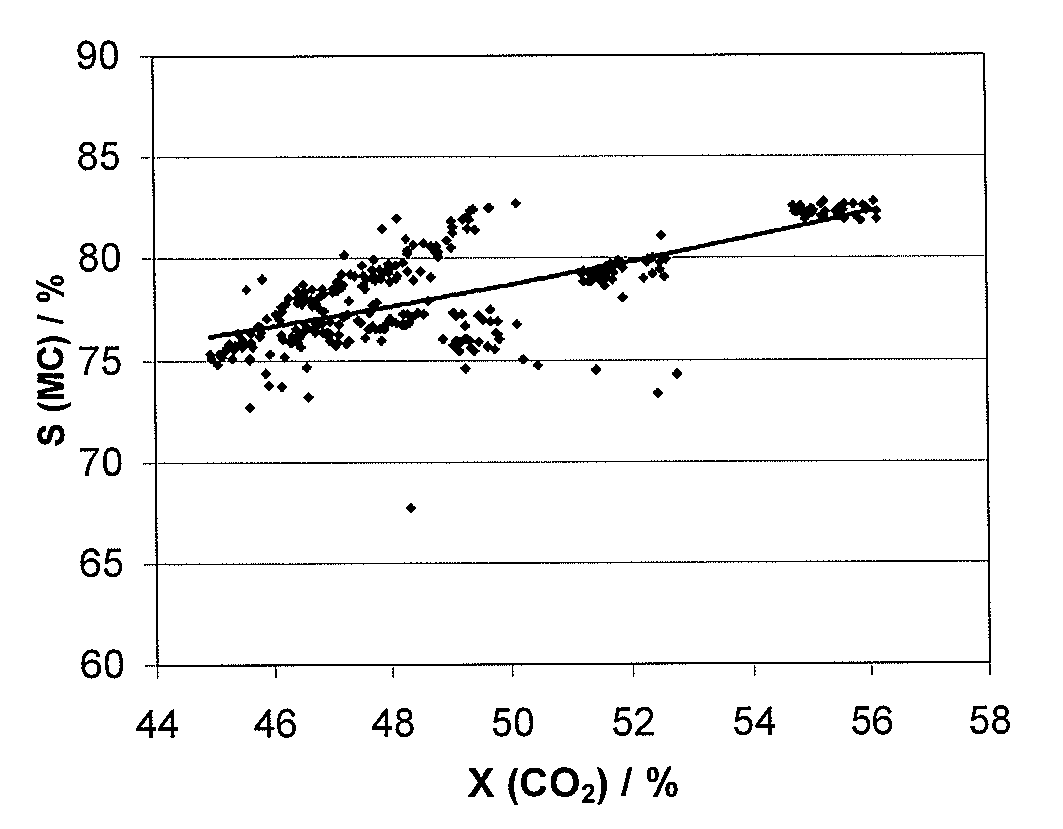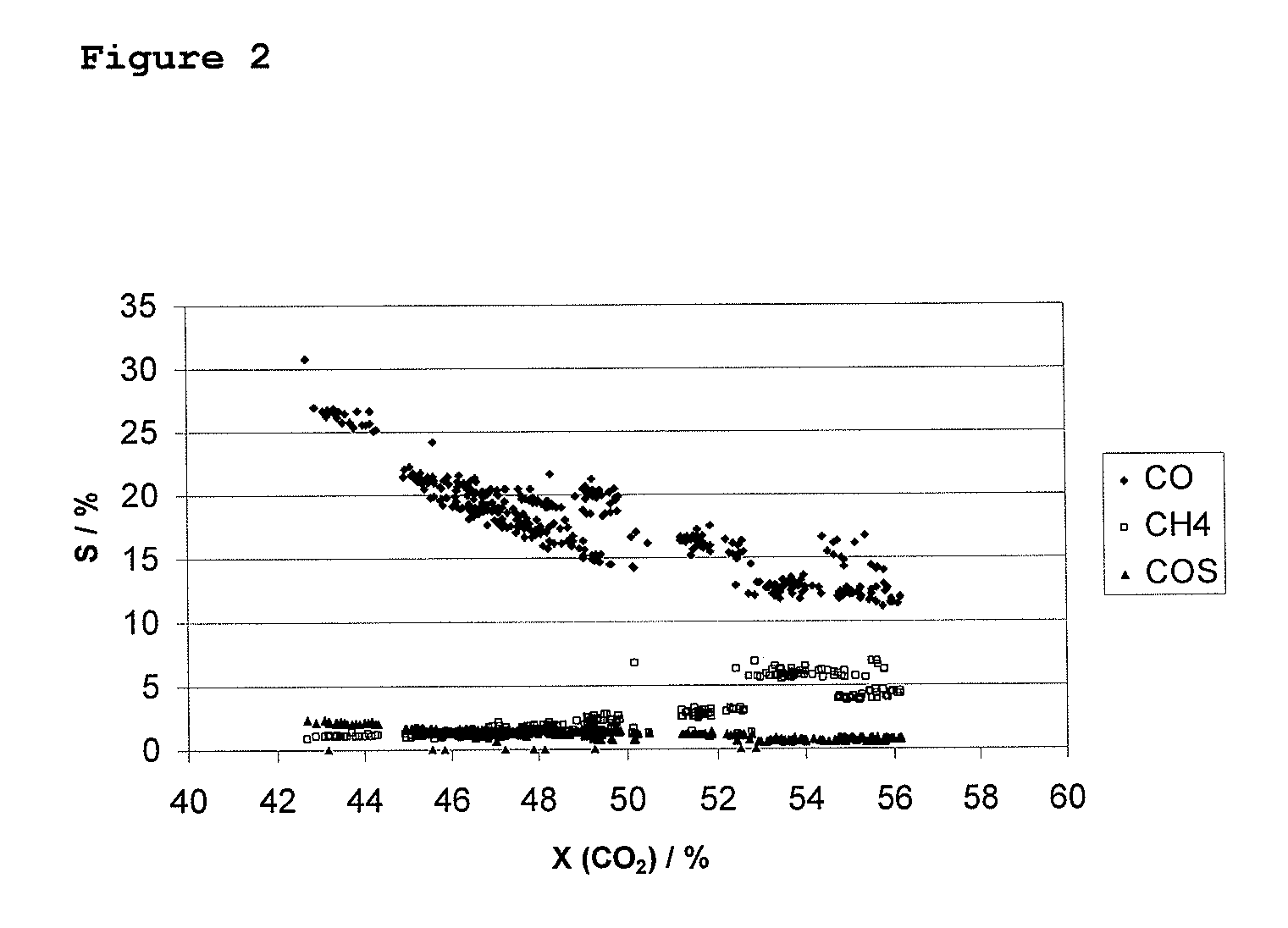Catalyst for the preparation of methyl mercaptan
- Summary
- Abstract
- Description
- Claims
- Application Information
AI Technical Summary
Benefits of technology
Problems solved by technology
Method used
Image
Examples
example 1
Preparation of the Catalysts A Through E
[0085]Catalyst A
[0086]An aqueous solution of 2.0635 g of perrhenium acid (HReO4) dissolved in 20 ml of distilled water was prepared. 50 g of TiO2-support were impregnated with 18 ml of this HReO4-solution under continuous stirring. The impregnated support was agitated for 5 min followed by aging for 30 min at room temperature. Subsequently, the material was dried in an oven at 100° C. for 4.5 h. An aqueous solution of 23.73 g of potassium molybdate dissolved in 25 ml of distilled water was prepared. The impregnated support was coated with 18 ml of the K2MoO4-solution. The second impregnation was performed analogous to the first impregnation-step. After aging for 30 min at room temperature the catalyst was dried in an oven at 100° C. for 2 h, followed by calcination at 500° C. (1 h).
[0087]Catalyst B
[0088]An ethanolic solution of 0.5882 g tributyl tin acetate dissolved in 31.9 g of ethanol was prepared. 19.8 g of catalyst A were impregnated with...
example 2
[0095]The catalysts A-E described in Example 1 were tested under the following reaction conditions: the total gas hourly space velocity was 750-3000 h−1, the reactant molar ratio for CO2 / H2 / H2S was 1 / 4 / 4, respectively and the catalyst bed temperature was 250-350° C. (maximum) and the absolute pressure was 30 bar. The catalytic activity was evaluated for a single-pass of the reactor. Determination of conversions and selectivities were made as described above.
TABLE 1Conver-SelectivitysionSelectivitySelectivity(CH4 orCatalystCarrier(CO2) / %(MC) / (CO) / %COS) / %Catalyst ATiO255.882.211.84.5Re2O7 / (CH4)K2MoO4 / TiO9Catalyst BTiO253.582.69.94.8SnO2 / (CH4)Re2O7 / K2MoO4 / TiO2Catalyst CTiO250.181.512.63.5MnxOY / (CH4)K2MoO4 / TiO2Catalyst DTiO248.580.413.93.4MnxOY / (CH4)K2MoO4 / TiO2Catalyst EAl2O3333.881.414.5 MnO2 / (COS)CsOH / Al2O3CO2 = carbon dioxideMC = methyl mercaptan
example 3
[0096]Table 2 shows the catalytic activity of a catalyst consisting of SnO2—Re2O7—K2MoO4-TiO2 impregnated on a Degussa Aerolyst TiO2 carrier with a loading of 1 wt % SnO2 as compared to a state-of-the-art Re2O7—Al2O3 catalyst. The materials were tested under the following reaction conditions: the total gas hourly space velocity was 400-3000 h−1, the reactant molar ratio for CO2 / H2 / H2S was 1 / 4 / 4, respectively, the catalyst bed temperature was 250-400° C. and the absolute pressure was 30 bar. The catalytic activity was evaluated for a single-pass of the reactor. Determination of conversions and selectivities were made as described above. Note the reduced formation of carbon monoxide and methane accompanied by significantly increased selectivities and yields of methyl mercaptan as compared to a Re2O7 catalyst impregnated on Al2O3-support material.
TABLE 2ConversionSelectivitySelectivitySelectivityCatalyst(CO2) / %Yield (MC) / %(MC) / %(CO) / %(CH4) / %1 wt % SnO2—Re2O7—K2MoO4—TiO253.544.282.69.94...
PUM
| Property | Measurement | Unit |
|---|---|---|
| Temperature | aaaaa | aaaaa |
| Pressure | aaaaa | aaaaa |
| Fraction | aaaaa | aaaaa |
Abstract
Description
Claims
Application Information
 Login to View More
Login to View More - R&D
- Intellectual Property
- Life Sciences
- Materials
- Tech Scout
- Unparalleled Data Quality
- Higher Quality Content
- 60% Fewer Hallucinations
Browse by: Latest US Patents, China's latest patents, Technical Efficacy Thesaurus, Application Domain, Technology Topic, Popular Technical Reports.
© 2025 PatSnap. All rights reserved.Legal|Privacy policy|Modern Slavery Act Transparency Statement|Sitemap|About US| Contact US: help@patsnap.com



